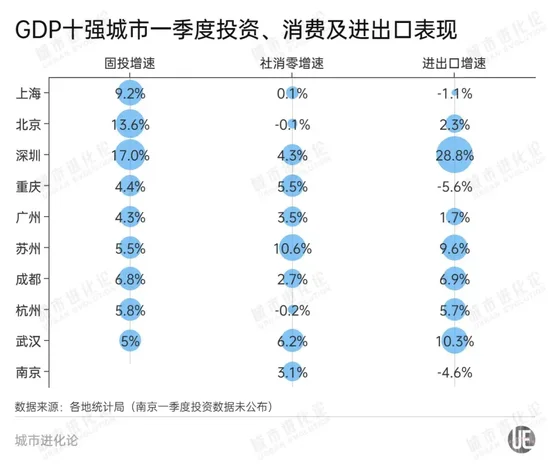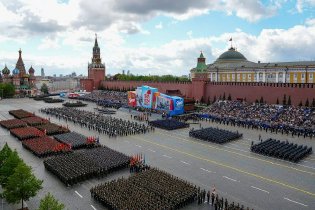Every reporter Dan Zhongkui
Who is left behind between fast and slow?
Up to now, the first quarter economic data of the top 30 cities with GDP in China have been released, including 26 "trillion club" cities and 4 "quasi trillion" cities such as Tangshan, Xuzhou, Dalian and Wenzhou.
From the growth rate in the first quarter, among the trillion cities, 14 cities including Suzhou outperformed the national market (5.3%) in terms of GDP growth, while Tianjin and Jinan were on the same level as the whole country. Among them, the GDP growth of Suzhou, Nantong and Quanzhou reached 7.9%, 7.2% and 7.2% respectively, ranking the top three; Foshan, Xi'an and Guangzhou ranked last with growth rates of 1.1%, 2.7% and 3.6% respectively. All four "quasi trillion" cities outperformed the national average.
Between speed and speed, the trillion city pattern ushers in a major "change"——
Chongqing has replaced Guangzhou to become the "fourth economic city" again. Suzhou has a weak advantage over Chengdu. Changsha has been overtaken by Wuxi and Zhengzhou consecutively, Nantong has overtaken Xi'an and Foshan, and Wenzhou has overtaken Dalian and Xuzhou and won the first seat of the "reserve corps"
In urban competition, if you don't advance, you will fall back. In the new round of trillion city competition, which cities are rising against the trend? Which cities tend to fall behind? What new signals are revealed behind this?
Chongqing surpasses Guangzhou and Suzhou reverses
Since this year, the performance of major economic markets has become more stable. In the first quarter of last year, only Shenzhen among the four first tier cities outperformed the national market in terms of GDP growth, while in the same period of this year, Shenzhen and Beijing both achieved growth rates of more than 6%.
In the first quarter of 2024, the GDP of Shanghai, Beijing, Shenzhen and Guangzhou will be 1109.846 billion yuan, 1058.14 billion yuan, 831.498 billion yuan and 716.114 billion yuan respectively, with growth rates of 5.0%, 6.0%, 6.4% and 3.6% respectively, showing an obvious warming trend compared with the same period last year.
Shenzhen, in particular, can be described as "peerless". From the perspective of the "troika", Shenzhen's fixed asset investment and total import and export growth rates were 17.0% and 28.8% respectively, ranking first and second among trillion cities.
Among them, the total import and export volume of Shenzhen reached 1.02 trillion yuan in the first quarter, breaking through the trillion yuan mark for the first time in the same period in ten years. At the same time, the growth rate of industrial added value above designated size has maintained a double-digit growth, reaching 11.5%, also ranking in the forefront of the country. The recovery of both industry and foreign trade also sends a signal that the economy of Shenzhen, a manufacturing city, is improving.

However, Guangzhou, the core city in the Pearl River Delta, is in a different situation. In the first quarter, Guangzhou's economic growth rate ranked the bottom among the top ten cities in GDP, while Chongqing's economic growth rate of 6.2% behind it again exceeded that of other cities. From the perspective of the growth rate of industrial added value above designated size, Guangzhou and Chongqing are 0.1% and 8.6% respectively, and the driving forces of industrial growth are quite different.
According to the analysis of Guangzhou Municipal Bureau of Statistics, in the first quarter, the economy of Guangzhou started smoothly under the influence of insufficient demand in the two major markets of fuel vehicles and real estate, as well as the challenges of its own industrial cyclical and structural factors. The expansion of the city's economy in terms of "quantity" and "quality" continued to show. However, the current economic operation of Guangzhou is still in the critical period of kinetic energy conversion and structural adjustment, facing problems such as unbalanced industry repair and the failure of new kinetic energy to effectively support growth.
In contrast, the transformation of Chongqing's automobile and other pillar industries has achieved initial results. In the first quarter, the output of new energy vehicles and ultra white glass for solar energy industry increased by 1 and 3 times respectively year on year.
Behind Guangzhou, Suzhou also successfully achieved a great reversal. In the whole year of last year, Suzhou ranked second to last with an economic growth rate of 4.6% with Guangzhou and Nanjing. In the first quarter of this year, its growth rate reached 7.9%, leading the trillion cities.
From the perspective of the "troika", Suzhou's investment, consumption and import and export growth rates in the first quarter were 5.5%, 10.6% and 9.6% respectively, ranking top among the top ten cities in terms of GDP. As a major manufacturing city in China, Suzhou's industrial added value growth above designated size reached 11% in the first quarter, forming a strong support.
Among them, the output value of electronic information and automobile manufacturing both achieved double-digit growth, with year-on-year growth of 10% and 15.8% respectively, and their contribution to the growth of Suzhou's industrial gross output value above designated size totaled 58.5%.
Nanjing is still the "gatekeeper" of the top ten cities, but its GDP growth rate in the first quarter was only 3.8%, ranking lower among the trillion cities. In recent years, Ningbo has constantly launched an impact on the top ten GDP. According to the data of the first quarter, the GDP of Nanjing, Ningbo and Tianjin were 435.956 billion yuan, 399.22 billion yuan and 389.008 billion yuan respectively. Ningbo temporarily exceeded Tianjin and was closer to Nanjing to less than 40 billion yuan.
Wuxi exceeds Changsha, Nantong exceeds Xi'an
Compared with the pattern of top ten cities with GDP, the pattern of the waist of trillions of cities has more ups and downs. After the "Three Kingdoms Killing" combination of Ningbo, Qingdao and Wuxi gradually disintegrated, the competition among Changsha, Wuxi and Zhengzhou attracted more and more attention.
In the first quarter of last year, the GDP of Changsha, Wuxi and Zhengzhou was 346.818 billion yuan, 339.179 billion yuan and 338.486 billion yuan respectively, with growth rates of 4.1%, 4.9% and 6.0% respectively. The biggest gap between the three was only about 8 billion yuan. Now, Wuxi and Zhengzhou have achieved the goal of surpassing Changsha by 6.8% and 6.2% respectively.
From the perspective of the "troika", Wuxi's overall performance is relatively excellent, while Zhengzhou and Changsha are facing the challenges of low investment growth and sharp decline in foreign trade.
The data shows that the growth rate of fixed asset investment in Wuxi, Zhengzhou and Changsha is 10.1%, 1.1% and 1.3% respectively, the growth rate of total retail sales of consumer goods is 5.9%, 4.7% and 7.2% respectively, and the growth rate of foreign trade import and export is 8.8%, - 32.3% and - 28.8% respectively.
Influenced by the international environment, industrial transfer and other factors, Foxconn's mobile phone production in Henan declined, leading to a sharp decline in imports and exports. According to the data of Zhengzhou Customs, in the first quarter of 2023, Henan province will export 16.88 million mobile phones, while in the same period of 2024, there will be only 6.64 million mobile phones, reducing by tens of millions. The amount of mobile phone exports also decreased from 71.1 billion yuan in the first quarter of 2023 to 27.2 billion yuan in the first quarter of 2024.
However, Zhengzhou is taking advantage of projects such as Zhengzhou BYD Factory and Zhengzhou SAIC Motor Passenger Vehicle Phase II to gradually cultivate new energy vehicles into the next engine. Whether for industrial economic growth or foreign trade development, the new energy automobile industry will become a key variable for Zhengzhou's "turning around".
In addition, among the trillions of cities, Nantong and Quanzhou ranked second in terms of GDP growth, second only to Suzhou. In the first quarter of this year, Nantong's GDP reached 298.22 billion yuan, an increase of 7.2% year on year, overtaking Xi'an and Foshan at one fell swoop, and ranking 17th in the national economic aggregate. Among them, the growth rate of industrial added value above the designated size of Nantong was as high as 11.3%, and the strong growth of industrial economy became an important support.
In contrast, Xi'an and Foshan are in the predicament of low growth. According to the data, the GDP of the two cities in the first quarter was 288.286 billion yuan and 287.265 billion yuan respectively, with growth rates of 2.7% and 1.1% respectively, which were both exceeded by about 10 billion yuan by Nantong. From the perspective of GDP growth, the two cities increased by only 4.875 billion yuan and - 0.25 billion yuan respectively compared with the same period last year. Foshan is also the only city with negative growth among trillion cities.
From the perspective of the "troika", Xi'an's investment growth rate is negative, the zero growth rate of social consumption is only 0.1%, and only the import and export growth rate reaches 7.4%, which is relatively outstanding. While the growth rate of import and export in Foshan dropped by 33.1%, the growth rate of investment and the growth rate of industrial added value above designated size were not announced.
However, Foshan Statistics Bureau pointed out that:
In the first quarter, the added value of Foshan's real estate industry decreased by 13.1% year on year, and the added value of industries above designated size, such as metal products industry, ceramic press and other special equipment manufacturing industry, rubber and plastic products industry, which are closely related to real estate, declined to varying degrees.
In contrast, Dongguan's economy, which is also located in the Pearl River Delta, has significantly warmed up. In the first quarter, Dongguan's GDP reached 275.268 billion yuan, up 5.5% year on year, 3.3 percentage points higher than the same period last year, of which the growth rate of industrial added value above designated size was as high as 10.1%, showing a bright performance.
On the whole, the strong growth of industrial economy in manufacturing cities has become the core driving force supporting them to compete for the first place. However, due to the influence of industrial structure and other factors, the proportion of quarterly GDP in the annual GDP of different cities varies greatly. The pattern challenger will face new challenges if he wants to truly establish his own advantages.
Wenzhou surpasses Dalian, while Tangshan lags behind
While trillions of cities are catching up with each other, how the quasi trillions of cities "break through" has also attracted much attention.
In 2023, the GDP of Tangshan, Xuzhou, Dalian and Wenzhou will be 913.33 billion yuan, 890.044 billion yuan, 875.29 billion yuan and 873.063 billion yuan, respectively. They are the "seed players" who are most likely to hit the trillion GDP in one or two years. On the basis of the relatively high growth rate in the same period last year, the four cities outperformed the national market in the first quarter of this year.
Data shows that in the first quarter, the GDP of Wenzhou, Xuzhou, Dalian and Tangshan was 215.22 billion yuan, 211.835 billion yuan, 210.35 billion yuan and 2006.5 billion yuan respectively, with year-on-year growth of 6.1%, 6.9%, 5.8% and 6.6%. Compared with the first quarter of last year, the GDP growth of the four cities reached 12.31 billion yuan, 10.21 billion yuan, 7.06 billion yuan and 7.61 billion yuan respectively.
This also makes the rank of backup cities interchangeable. In the first quarter of 2023, Dalian's GDP reached 203.29 billion yuan, leading Wenzhou and Xuzhou by a small margin, but now it has been overtaken by both Wenzhou and Xuzhou.
From the perspective of the growth rate of industrial added value, Wenzhou, Xuzhou, Dalian and Tangshan are 10.7%, 6.9%, 7.2% and 9.5% respectively. The growth momentum of industrial economy is very strong.
In particular, Wenzhou, at the "first meeting of the Spring Festival" this year, officially launched the battle drum for the "double ten thousand" city, and successively issued the "Ten Action Plans of Wenzhou City for" Promoting Consumption, Expanding Investment, and Stabilizing Production "in the first quarter of 2024, and the" Action Plan of Wenzhou City for "Competing for the First Quarter, and Rushing to Open the Door to Prosperity" investment, to promote the implementation of major projects in a list way.
Data shows that this year, 116 projects in Wenzhou have been selected as major projects of the provincial "1000 trillion" project, with a total investment of 456.8 billion yuan and an annual investment plan of 54.1 billion yuan.
Xuzhou also stepped up its planning for the next city after achieving a "good start" in the first quarter. "The second quarter is not only a key node connecting the past and the future, but also a key period determining the economic trend of the whole year." At the first quarter economic situation analysis meeting, Song Lewei, the secretary of Xuzhou Municipal Party Committee, stressed that more efforts should be made to attract investment projects, and the "Year of Quality and Efficiency Improvement of Investment Attraction" action should be carried out in depth to constantly consolidate the foundation of economic growth.
The situation in Dalian is not optimistic. Although the GDP growth rate in the first quarter (5.8%) outperformed the national market, the growth rates of investment, consumption and import and export were 3.8%, 3.7% and - 8.9% respectively, which were lower than the national average. This also increasingly exposes Dalian's deep-seated weaknesses. From the outside world's perspective, Dalian's industrial structure is still dominated by heavy industry and petrochemical industry. The slow growth of emerging industries has restricted the transformation and upgrading of the economic structure.
Not long ago, the conference on the promotion of high-quality development of the software and information technology service industry in Dalian was held, which proposed to revitalize the software and information technology service industry with the strength of the whole city. Xiong Maoping, Secretary of the CPC Dalian Municipal Committee, stressed that it is necessary to accurately grasp the new trends, new characteristics and new changes of the current software industry development, accelerate the development of the long board, complement the short board, forge new board, consolidate the industrial foundation, innovate the industrial structure, optimize the industrial ecology, and accelerate the building of a software city with international competitiveness. This will also be an important direction for Dalian to smash the trillion club.
As far as Tangshan is concerned, although the first quarter is temporarily lagging behind, its GDP has always accounted for a higher proportion in the second half of the year. Whether it can take the lead in reaching the threshold of a trillion club remains a big mystery.
reporter | Dan Zhongkui
Editor in charge: Zhang Di


















